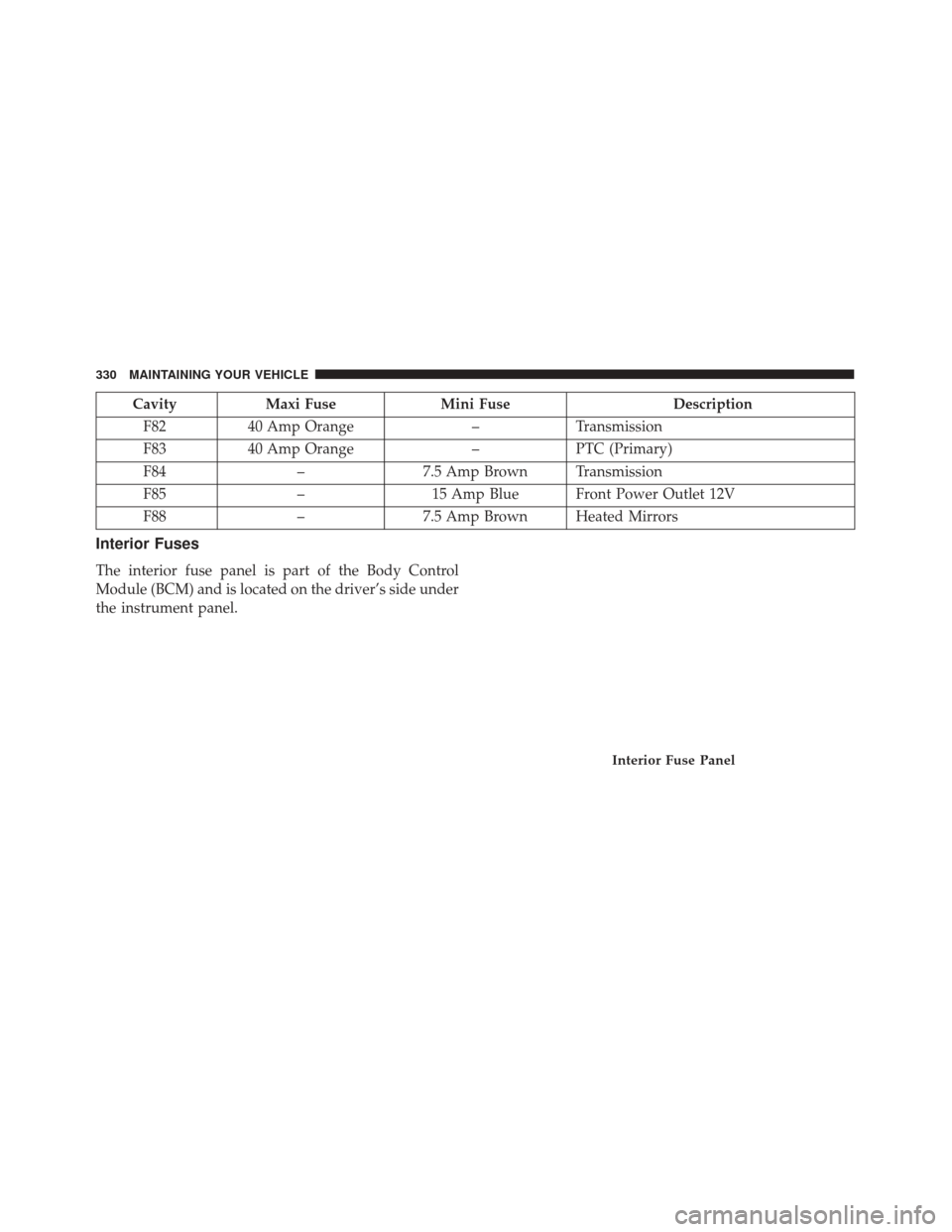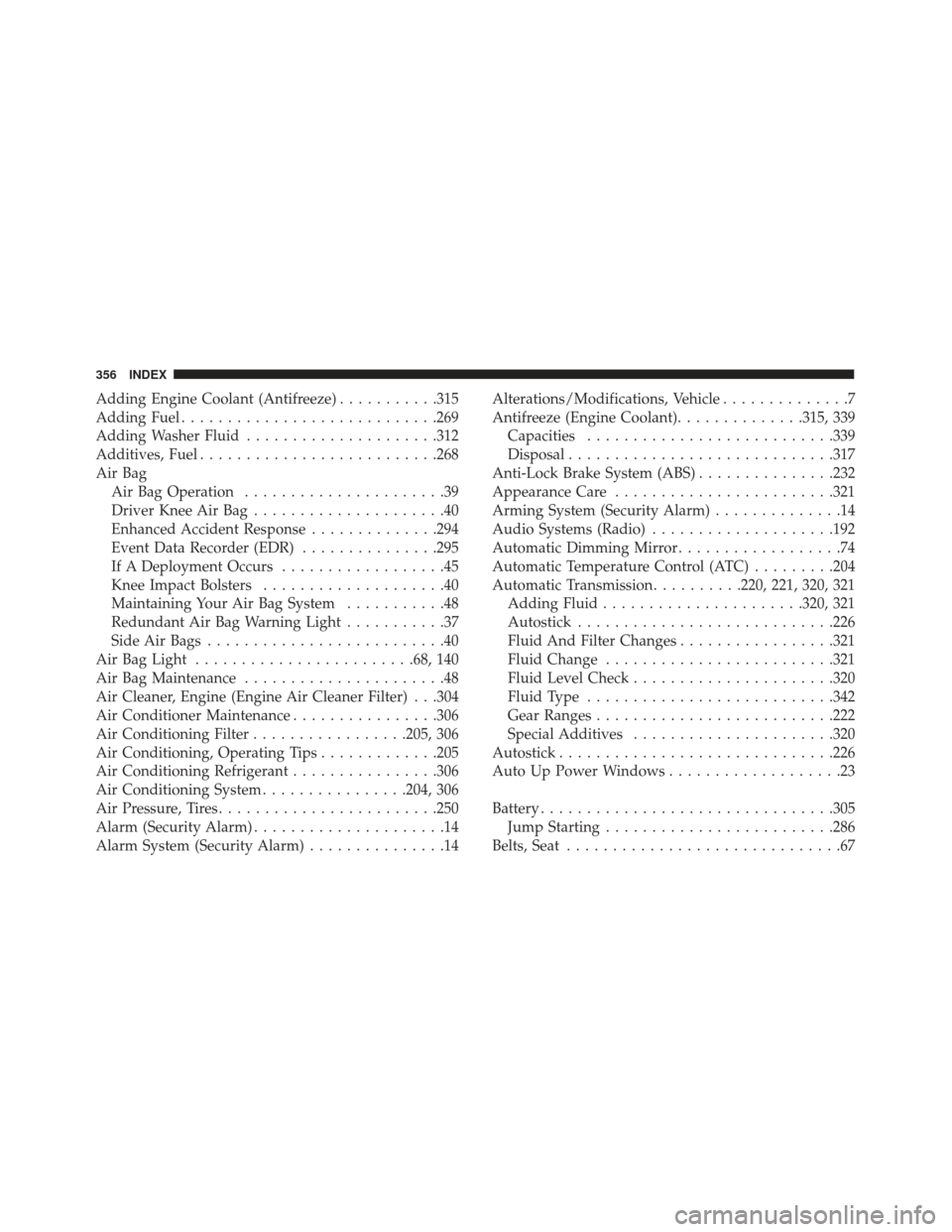2017 FIAT 500L transmission
[x] Cancel search: transmissionPage 304 of 370

MAINTENANCE PROCEDURES
The pages that follow contain therequiredmaintenance
services determined by the engineers who designed
your vehicle.
Besides those maintenance items specified in the fixed
maintenance schedule, there are other components
which may require servicing or replacement in the
future.
CAUTION!
• Failure to properly maintain your vehicle or per-
form repairs and service when necessary could
result in more costly repairs, damage to other
components or negatively impact vehicle perfor-
mance. Immediately have potential malfunctions
examined by an authorized dealer or qualified
repair center.
• Your vehicle has been built with improved fluids
that protect the performance and durability of
your vehicle and also allow extended mainte-
nance intervals. Do not use chemical flushes in
these components as the chemicals can damage
(Continued)
CAUTION! (Continued)
your engine, transmission, or air conditioning.
Such damage is not covered by the New Vehicle
Limited Warranty. If a flush is needed because of
component malfunction, use only the specified
fluid for the flushing procedure.
Engine Oil
Checking Oil Level
To assure proper engine lubrication, the engine oil must
be maintained at the correct level. Check the oil level at
regular intervals, such as every fuel stop. The best time
to check the engine oil level is approximately five
minutes after a fully warmed engine is shut off. Do not
check oil level before starting the engine after it has sat
overnight. Checking engine oil level when the engine is
cold will give you an incorrect reading.
Checking the oil while the vehicle is on level ground,
and approximately five minutes after a fully warmed
engine is shut off, will improve the accuracy of the oil
level readings. Maintain the oil level between the range
markings on the dipstick. The safe range is indicated by
a crosshatch zone. Adding 1 quart (0.9 Liters) of oil
302 MAINTAINING YOUR VEHICLE
Page 315 of 370

CAUTION!
•The catalytic converter requires the use of un-
leaded fuel only. Leaded gasoline will destroy the
effectiveness of the catalyst as an emissions con-
trol device and may seriously reduce engine per-
formance and cause serious damage to the engine.
• Damage to the catalytic converter can result if
your vehicle is not kept in proper operating
condition. In the event of engine malfunction,
particularly involving engine misfire or other
apparent loss of performance, have your vehicle
serviced promptly. Continued operation of your
vehicle with a severe malfunction could cause the
converter to overheat, resulting in possible dam-
age to the converter and vehicle.
Under normal operating conditions, the catalytic con-
verter will not require maintenance. However, it is
important to keep the engine properly tuned to assure
proper catalyst operation and prevent possible catalyst
damage. NOTE:
Intentional tampering with emissions control
systems can result in civil penalties being assessed
against you.
In unusual situations involving grossly malfunctioning
engine operation, a scorching odor may suggest severe
and abnormal catalyst overheating. If this occurs, stop
the vehicle, turn off the engine and allow it to cool.
Service, including a tune-up to manufacturer’s specifi-
cations, should be obtained immediately.
To minimize the possibility of catalytic converter dam-
age:
• Do not shut off the engine or interrupt the ignition,
when the transmission is in gear and the vehicle is in
motion.
• Do not try to start the engine by pushing or towing
the vehicle.
• Do not idle the engine with any spark plug wires
disconnected or removed, such as when diagnostic
testing, or for prolonged periods during very rough
idle or malfunctioning operating conditions.
7
MAINTAINING YOUR VEHICLE 313
Page 322 of 370

Automatic Transmission
Selection Of Lubricant
It is important to use the proper transmission fluid to
ensure optimum transmission performance and life.
Use only the manufacturer ’s specified transmission
fluid. Refer to “Fluids, Lubricants, And Genuine Parts”
in this section for fluid specifications. It is important to
maintain the transmission fluid at the correct level
using the recommended fluid. No chemical flushes
should be used in any transmission; only the approved
lubricant should be used.
CAUTION!
Using a transmission fluid other than the manufac-
turer ’s recommended fluid may cause deterioration
in transmission shift quality and/or torque con-
verter shudder. Refer to “Fluids, Lubricants, And
Genuine Parts” in this section for fluid specifica-
tions.
Special Additives
The manufacturer strongly recommends against using
any special additives in the transmission.Automatic Transmission Fluid (ATF) is an engineered
product and its performance may be impaired by
supplemental additives. Therefore, do not add any fluid
additives to the transmission. The only exception to this
policy is the use of special dyes for diagnosing fluid
leaks. Avoid using transmission sealers as they may
adversely affect seals.
CAUTION!
Do not use chemical flushes in your transmission as
the chemicals can damage your transmission com-
ponents. Such damage is not covered by the New
Vehicle Limited Warranty.
Fluid Level Check
The fluid level is preset at the factory and does not
require adjustment under normal operating conditions.
Routine fluid level checks are not required, therefore the
transmission has no dipstick. Your authorized dealer
can check your transmission fluid level using special
service tools. If you notice fluid leakage or transmission
malfunction, visit your authorized dealer immediately
to have the transmission fluid level checked. Operating
320 MAINTAINING YOUR VEHICLE
Page 323 of 370

the vehicle with an improper fluid level can cause
severe transmission damage.
CAUTION!
If a transmission fluid leak occurs, visit your autho-
rized dealer immediately. Severe transmission dam-
age may occur. Your authorized dealer has the
proper tools to adjust the fluid level accurately.
Fluid And Filter Changes
Under normal operating conditions, the fluid installed
at the factory will provide satisfactory lubrication for
the life of the vehicle. Routine fluid and filter changes
are not required. However, change the fluid and filter if
the fluid becomes contaminated (with water, etc.), or if
the transmission is disassembled for any reason.
Appearance Care And Protection From
Corrosion
Protection Of Body And Paint From Corrosion
Vehicle body care requirements vary according to geo-
graphic locations and usage. Chemicals that make roads
passable in snow and ice and those that are sprayed on
trees and road surfaces during other seasons are highlycorrosive to the metal in your vehicle. Outside parking,
which exposes your vehicle to airborne contaminants,
road surfaces on which the vehicle is operated, extreme
hot or cold weather and other extreme conditions will
have an adverse effect on paint, metal trim, and under-
body protection.
The following maintenance recommendations will en-
able you to obtain maximum benefit from the corrosion
resistance built into your vehicle.
What Causes Corrosion?
Corrosion is the result of deterioration or removal of
paint and protective coatings from your vehicle.
The most common causes are:
•
Road salt, dirt and moisture accumulation.
• Stone and gravel impact.
• Insects, tree sap and tar.
• Salt in the air near seacoast localities.
• Atmospheric fallout/industrial pollutants.7
MAINTAINING YOUR VEHICLE 321
Page 331 of 370

CavityMaxi Fuse Mini Fuse Description
F06 30 Amp Green –Radiator Fan - Low Speed
F07 50 Amp Red –Radiator Fan - High Speed
F08 40 Amp Orange –Blower Motor
F09 – –Not Used
F09 –5 Amp Tan Transmission (Aisin)
F10 –15 Amp Blue Horn
F11 –10 Amp Red Powertrain
F14 –20 Amp Yellow Power Outlet 115V
F15 – –Not Used
F15 –10 Amp Red Transmission (Aisin)
F16 –7.5 Amp Brown Transmission Powertrain
F17 –10 Amp Red Powertrain
F18 –5 Amp Tan Powertrain (Multiair – If Equipped)
F19 –7.5 Amp Brown Air Conditioning
F20 –30 Amp Green Rear Defroster
F21 –15 Amp Blue Fuel Pump
F22 –20 Amp Yellow Powertrain
F23 –20 Amp Yellow Anti-Lock Brake Valves
F30 –5 Amp Tan After Run Pump
F81 70 Amp Tan –PTC (Secondary)
7
MAINTAINING YOUR VEHICLE 329
Page 332 of 370

CavityMaxi Fuse Mini Fuse Description
F82 40 Amp Orange –Transmission
F83 40 Amp Orange –PTC (Primary)
F84 –7.5 Amp Brown Transmission
F85 –15 Amp Blue Front Power Outlet 12V
F88 –7.5 Amp Brown Heated Mirrors
Interior Fuses
The interior fuse panel is part of the Body Control
Module (BCM) and is located on the driver’s side under
the instrument panel.
Interior Fuse Panel
330 MAINTAINING YOUR VEHICLE
Page 344 of 370

Chassis
ComponentFluid, Lubricant, or Genuine Part
Automatic Transmission Use only MOPAR AW-1 Automatic Transmission Fluid
or equivalent. Failure to use the correct fluid may affect
the function or performance of your transmission.
Brake Master Cylinder We recommend you use MOPAR DOT 4. If DOT 4 brake
fluid is not available, then DOT 3 is acceptable.
If using DOT 4 brake fluid, the fluid must be changed
every 24 months. This interval is time based only,
mileage intervals do not apply.
342 MAINTAINING YOUR VEHICLE
Page 358 of 370

Adding Engine Coolant (Antifreeze)...........315
Adding Fuel ............................269
Adding Washer Fluid .....................312
Additives, Fuel ..........................268
Air Bag Air Bag Operation ......................39
Driver Knee Air Bag .....................40
Enhanced Accident Response ..............294
Event Data Recorder (EDR) ...............295
If A Deployment Occurs ..................45
Knee Impact Bolsters ....................40
Maintaining Your Air Bag System ...........48
Redundant Air Bag Warning Light ...........37
Side Air Bags ..........................40
Air Bag Light ........................68, 140
Air Bag Maintenance ......................48
Air Cleaner, Engine (Engine Air Cleaner Filter) . . .304
Air Conditioner Maintenance ................306
Air Conditioning Filter .................205, 306
Air Conditioning, Operating Tips .............205
Air Conditioning Refrigerant ................306
Air Conditioning System ................204, 306
Air Pressure, Tires ........................250
Alarm (Security Alarm) .....................14
Alarm System (Security Alarm) ...............14Alterations/Modifications, Vehicle
..............7
Antifreeze (Engine Coolant) ..............315, 339
Capacities .......................... .339
Disposal ............................ .317
Anti-Lock Brake System (ABS) ...............232
Appearance Care ........................321
Arming System (Security Alarm) ..............14
Audio Systems (Radio) ....................192
Automatic Dimming Mirror ..................74
Automatic Temperature Control (ATC) .........204
Automatic Transmission ..........220, 221, 320, 321
Adding Fluid ..................... .320, 321
Autostick ............................226
Fluid And Filter Changes .................321
Fluid Change ........................ .321
Fluid Level
Check ..................... .320
Fluid Type .......................... .342
Gear Ranges ..........................222
Special Additives ..................... .320
Autostick ............................. .226
Auto Up Power Windows ...................23
Battery ............................... .305
Jump Starting ........................ .286
Belts, Seat ..............................67
356 INDEX